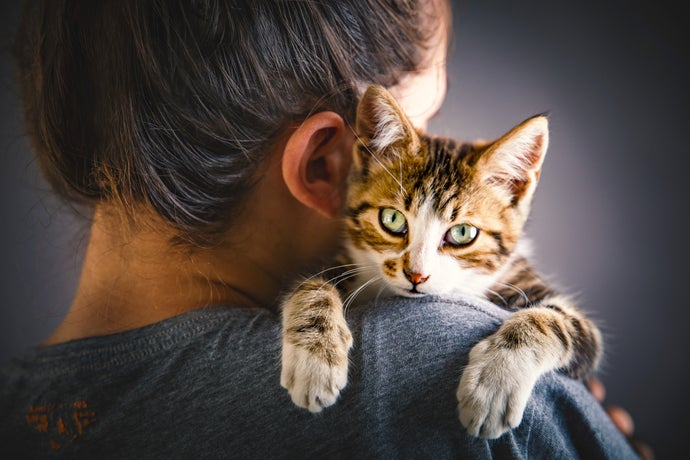(单词翻译:单击)
听力文本
This is Scientific American's 60-second Science. I'm Karen Hopkin.
When we think about pets, we often consider dogs to be overly attentive and cats, well, a bit more aloof. But a new study shows that cats can become attached to their humans—and will turn to that person for comfort in times of stress. The findings a-purr in the journal Current Biology.
Although kitties are a popular pet—more people own cats than dogs here in the U.S.—there are few studies that examine how the furtive felines feel about their owners.
"There has actually been very little research into the cat-human bond. Especially when we compare it to the number of research studies with dogs and humans."
Kristyn Vitale, a postdoctoral scholar at Oregon State University.
To explore the cat-caregiver connection, Vitale and her colleagues turned to a test that's been used to assess bonding behavior in puppies, apes and even infants.
The researchers would show a cat and its owner to an unfamiliar room and leave them there for two minutes—at which point the owner would depart, leaving the cat on its own.
"We know that human infants' attachment behavior toward their parents is heightened in response to a frightening or novel situation. So in this case, the experience of the cat being in the novel room alone acts as our strange situation and allows us to observe if the cat directs any attachment behaviors to the owner when they then come back to the room."

When the owners returned, Vitale and company would observe their reunion. And they saw that the felines displayed a variety of cat-itudes.
"So some cats greeted their owner, and then they returned to exploring the room while periodically going back to their owner for attention."
These kitties are apparently secure enough in their relationship that some quick reassurance was all they needed before continuing to purr-sue their purr-usal of the room.
On the other paw, some were real scary cats:
"Other cats behaved in an insecure way and excessively clung to their owner's side."
And then there were the cats that lived up to their reputation for supercilious standoffishness:
"Other cats avoided their owner when they returned to the room. These secure and insecure patterns of behavior are actually the same as what we observe between dogs and their owners and even human infants and their caregivers. In all three of these populations, the majority of individuals are actually securely attached to their caregivers, indicating similarities across these species."
Although snubbing is generally considered classic cat conduct:
"The majority of cats in the study, around 65 percent, actually use their owners as a source of security."
Why, one could even describe those cat-human relationships as dogged.
Thanks for listening for Scientific American's 60-second Science. I'm Karen Hopkin.
参考译文
这里是科学美国人——60秒科学。我是凯伦·霍普金。
我们想到宠物时,通常会认为狗狗过分体贴,而猫则有点冷漠。但一项新研究表明,猫咪可能变得依恋主人,而且在压力大的时候会向主人寻求安慰。这项研究结果发表在《当代生物学》期刊上。
尽管猫咪是受欢迎的宠物——美国养猫比养狗的人多——但几乎没有研究调查猫对主人的感觉。
“事实上,关注人猫关系的研究非常少。尤其是与人狗关系的研究相比时,更是如此。”
俄勒冈州立大学博士后学者克丽丝汀·维达莱说到。
为了探索狗和看护者之间的联系,维达莱及其同事采用了一种测试,这种测试被用来评估小狗、猿甚至人类婴儿的粘附行为。
研究人员会把猫及其主人带到一个不熟悉的房间,让二者留在房间里两分钟,然后主人离开,将猫独自留在房间里。
“我们知道,面对恐惧或新情况时,人类婴儿对父母的依恋行为会增加。在这项实验中,猫独自呆在新房间的体验就是陌生情况,我们可以观察到猫是否会在主人回到房间时做出任何依恋行为。”
当主人回来时,维达莱和同伴会观察团聚情况。他们看到,猫咪展现出各种各样的态度。
“有些猫向主人打了招呼,然后回去继续探索房间,时不时地回到主人身边寻求关注。”
这些猫咪在关系中显然足够安全,所以在继续探索房间前,它们只需要一些快速安慰。
另一方面,有些猫是真正胆小的猫:
“其它猫咪表现得缺乏安全感,而且会过分地黏在主人身边。”
还有一些猫没有辜负它们“高傲冷漠”的名声:
“其它的猫看到主人回到房间会躲避。这些安全和不安全的行为模式,实际上与我们观察狗与主人甚至人类婴儿及其看护者时看到的一样。在这三个种群中,大多数个体都会安心地依恋其看护者,这表明这些物种存在相似性。”
尽管人们普遍认为“冷漠”是经典的猫咪行为:
“在研究中,大多数猫咪——65%左右——将主人当作安全来源。”
人们甚至会把这种猫与人的关系形容为“顽强”。
谢谢大家收听科学美国人——60秒科学。我是凯伦·霍普金。
译文为可可英语翻译,未经授权请勿转载!
重点讲解
重点讲解:
1. on one's own 单独地;独自地;
He lives on his own.
他独自一人生活。
2. cling to 缠住;依附;
I was terrified he would leave me, so I was clinging to him.
我害怕他会离开我,所以缠着他不放。
3. live up to 遵守(诺言);符合,不辜负(期望);
The Festival aims to live up to its reputation as a trail-blazing event.
该艺术节志在不虚负其先锋性活动的声名。
4. the same as 与…一样;
I mean, it's a relationship, the same as a marriage is a relationship.
我的意思是它是一种人际关系,就如同婚姻也是一种人际关系一样。


